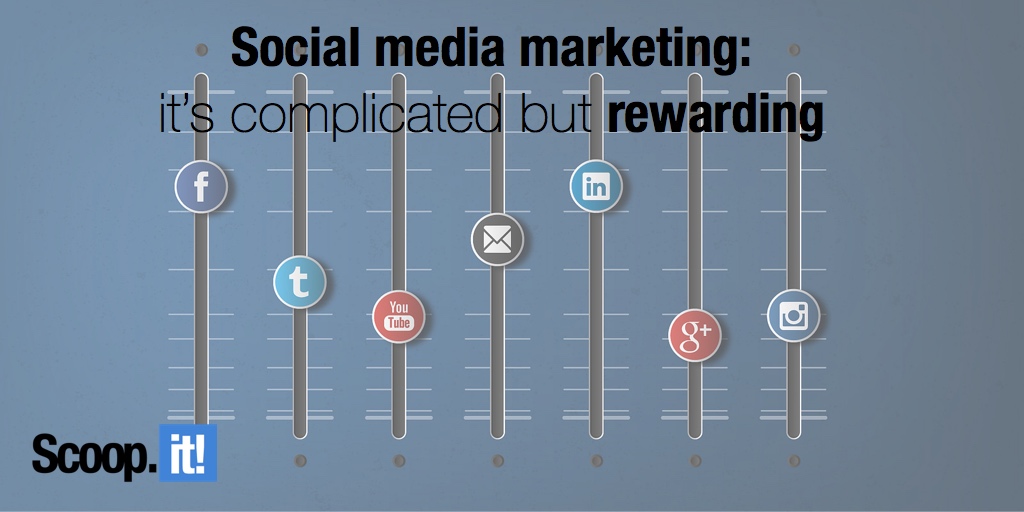
Facebook, Twitter, Instagram, LinkedIn and Pinterest boast a combined total of 2.5 billion active users. Let that sink in: there are 2.5 billion regularly updated accounts on those five platforms alone, so it’s no wonder that every company in the world wants to grab their own slice of social pie, reaching out to new and targeted audiences in the hope of making pounds and pence, dollars and cents. While it certainly takes plenty of time to get right, social media marketing is an incredibly powerful tool for building brands as well as for increasing audience engagement.
The only trouble is, most businesses rely on simply ‘doing’ social rather than actually ‘being’ social, which amounts to having an ad-hoc presence instead of a clear strategy for growth.
Part of the problem is the sheer proliferation of channels, so it’s important to research your target market and figure out which platforms are best suited to you, otherwise you could easily spread yourself too thin and waste time in the wrong place. In short, LinkedIn and Twitter should be essential for B2B marketers wanting to establish themselves, posting thought leadership pieces to highlight expertise and make the right connections, whereas B2C companies might want to cover more bases, so long as there’s a sufficient audience.
Engage
Genuine engagement is the key to success; there’s little point in posting content if your followers just scroll by, so you should always look to create conversation, build rapport and interact with people. Local businesses can benefit from regional hashtags, letting people know where they are and what they’re up to. There are also hundreds of discussion hours on Twitter, such as #UKBizLunch from midday-1pm, allowing B2B providers a networking opportunity. Most towns and cities also have their own local variation on this.
If you can go one step further and get customers to create content on your behalf, then they’re going to feel even more connected to your brand. Peperami recently challenged its fans to record videos showing ‘how they roll’, using the hashtag #HowIPeperamiRoll
The prize of the offer was a shiny Rolls Royce, which triggered thousands of entries across Facebook, Twitter, Vine and YouTube. The concept was simple, opening the door to anyone with a smartphone and a bit of creativity, resulting in a ton of highly-shareable, user-generated content.
This is #HowIPeperamiRoll. Tweet your own vid/pics with the hashtag or go to https://t.co/t4epjEcyrp https://t.co/MEaCN7ngs3
— Brad white (@Brad_white_95) December 2, 2015
This is the key to engagement; find something your followers can connect with and then asking them to share, like or interact. On this occasion, participants were entered into a prize draw for the blinged-up Roller, but Peparami also ran other competitions whereby the person who achieves the highest number of shares will take home a prize, meaning that their brand organically spreads across news feeds and timelines all over the world.
This is #HowIPeperamiRoll tweet your own vid/pics with the hashtag or go to https://t.co/msNehutBQw #ad https://t.co/nAmHxvZkZH
— Leslie Wai (@LeslieWai) December 2, 2015
Visualize
Video is the most shared type of content on Facebook, and research has shown that visual content outperforms text. Therefore, having a strong video at the heart of your campaign has become integral to successful online marketing, and video seeding ensures that your content reaches the right people, whether through paid platforms or influencer outreach.
If you have multiple social media accounts, it’s always a good idea to post native content because the algorithms will favor it; uploading specific Facebook videos will achieve a higher reach than linking to YouTube clips, as Facebook (and others) try to keep users on their own platform.
However, that’s not to say you should discount YouTube – far from it! YouTube is the world’s second largest search engine and gets 4 billion hits every single day, so hosting your video content here could prove to be very rewarding.
For Instagram, while it’s perfectly fine to distribute some images across multiple platforms, if you keep a good proportion of them back it will give people a reason to follow you here as well, rather than just waiting for your pictures to appear on Twitter or Facebook. B2B firms may not see the point in Instagram, but creating unique images is a great way of showcasing the culture of your company.
Conclusion
Social media might seem like a complicated beast to master, but if you do your homework and stay committed you’ll see engagement levels rise, which should lead to a boost for the bottom line.
And if you’d like to learn more great tips on ways to improve your SEO rankings, you should download this free eBook!
Image by Alan O’Rourke.



Good article. I have struggled with social media and this should get my mind on track. Tons of people in the fashion industry use social media and I have to get on board with it. Thanks.